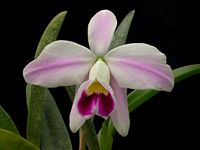Epidendroideae: Difference between revisions
Jump to navigation
Jump to search

imported>Chris Day No edit summary |
imported>Dalton Holland Baptista No edit summary |
||
| Line 1: | Line 1: | ||
{{subpages}} | {{subpages}} | ||
'''''Epidendroideae''''' is the largest subfamily of ''Orchidaceae'', with three quarters of all known [[species]], split into several [[tribe]]s and subtribes, encompassing more than five hundred [[genera]] and about twenty thousand species distributed almost all over the world, except in the dryer deserts and polar areas | {{taxobox | ||
| name =''Epidendroideae'' | |||
| color =lightgreen | |||
| image =Hadrolaelia pumila Imperatriz.JPG | |||
| image_caption =''Hadrolaelia pumila'' | |||
| domain = [[Eukaryota]] | |||
| regnum = [[Plantae]] | |||
| divisio = [[Magnoliophyta]] | |||
| classis = [[Liliopsida]] | |||
| ordo = [[Asparagales]] | |||
| familia = [[Orchidaceae]] | |||
| subfamilia = [[Epidendroideae]] | |||
| subfamilia_authority = [[Lindl.]] 1821 | |||
| type_genus =''[[Epidendrum]]''<small> [[L.]] 1753</small> | |||
| subdivision_ranks = Tribi | |||
| subdivision = | |||
*''[[Arethuseae]]'' | |||
*''[[Calypsoeae]]'' | |||
*''[[Collabieae]]'' | |||
*''[[Cymbidieae]]'' | |||
*''[[Dendrobieae]]'' | |||
*''[[Epidendreae]]'' | |||
*''[[Gastrodieae]]'' | |||
*''[[Malaxideae]]'' | |||
*''[[Neottieae]]'' | |||
*''[[Nervilieae]]'' | |||
*''[[Podochileae]]'' | |||
*''[[Sobralieae]]'' | |||
*''[[Triphoreae]]'' | |||
*''[[Tropidieae]]'' | |||
*''[[Vandeae]]'' | |||
*''[[Xerorchideae]]'' | |||
| subdivision2_ranks = Synonyms | |||
| subdivision2 = | |||
*Arethusoideae | |||
*Kerosphaeroideae | |||
*Limodoroideae | |||
*Malaxidoideae | |||
*Neottioideae | |||
*Tropidoideae | |||
*Vandoideae | |||
}} | |||
'''''Epidendroideae''''' is the largest subfamily of ''Orchidaceae'', with three quarters of all known [[species]], split into several [[tribe]]s and subtribes, encompassing more than five hundred [[genera]] and about twenty thousand species distributed almost all over the world, except in the dryer deserts and polar areas. They are known for being orchids with coherent [[pollen]] forming pollinia and with one incumbent [[anther]] only, or with the anther bent back, but then with clearly plicate leaves and roots hardly ever fleshy. | |||
Except for ''[[Vanilla]]'' species which belong to subfamily [[Vanilloideae]], the species of [[Cypripedioideae]] and a few others cultivated by specialists and by botanic gardens, almost the totality of cultivated orchids belong to Epidendroideae. | |||
Revision as of 21:45, 8 March 2009
| Epidendroideae | ||||||||||||||
|---|---|---|---|---|---|---|---|---|---|---|---|---|---|---|
 Hadrolaelia pumila
| ||||||||||||||
| Scientific classification | ||||||||||||||
| ||||||||||||||
| Type genus | ||||||||||||||
| Epidendrum L. 1753 | ||||||||||||||
| Tribi | ||||||||||||||
| Synonyms | ||||||||||||||
|
Epidendroideae is the largest subfamily of Orchidaceae, with three quarters of all known species, split into several tribes and subtribes, encompassing more than five hundred genera and about twenty thousand species distributed almost all over the world, except in the dryer deserts and polar areas. They are known for being orchids with coherent pollen forming pollinia and with one incumbent anther only, or with the anther bent back, but then with clearly plicate leaves and roots hardly ever fleshy.
Except for Vanilla species which belong to subfamily Vanilloideae, the species of Cypripedioideae and a few others cultivated by specialists and by botanic gardens, almost the totality of cultivated orchids belong to Epidendroideae.